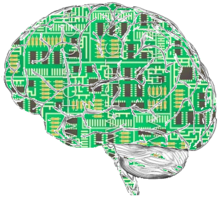
Mind uploading—transferring an individual's personality to a computer—appears in several works of fiction.[1] It is distinct from the concept of transferring a consciousness from one human body to another.[2][3] It is sometimes applied to a single person and other times to an entire society.[4] Recurring themes in these stories include whether the computerized mind is truly conscious, and if so, whether identity is preserved.[5] It is a common feature of the cyberpunk subgenre,[6] sometimes taking the form of digital immortality.[3][7]
- ^ Langford, David; Stableford, Brian (2022). "Upload". In Clute, John; Langford, David; Sleight, Graham (eds.). The Encyclopedia of Science Fiction (4th ed.). Retrieved 2024-03-29.
- ^ Webb, Stephen (2017). "Mind Uploading". All the Wonder that Would Be: Exploring Past Notions of the Future. Science and Fiction. Springer. pp. 276–278. doi:10.1007/978-3-319-51759-9_10. ISBN 978-3-319-51759-9.
- ^ a b
- Fischer, John Martin; Curl, Ruth (1996). "Philosophical Models of Immortality in Science Fiction". In Slusser, George; Westfahl, Gary; Rabkin, Eric S. (eds.). Immortal Engines: Life Extension and Immortality in Science Fiction and Fantasy. Athens, Georgia: University of Georgia Press. pp. 3–12. ISBN 0-8203-1733-0. OCLC 34319944.
- Fischer, John Martin; Curl, Ruth (2009). "Appendix to Chapter 6: Philosophical Models of Immortality in Science Fiction". In Fischer, John Martin (ed.). Our Stories: Essays on Life, Death, and Free Will. Oxford University Press. pp. 93–101. ISBN 978-0-19-537495-7.
- ^ Langford, David (2005). "Computers". In Westfahl, Gary (ed.). The Greenwood Encyclopedia of Science Fiction and Fantasy: Themes, Works, and Wonders. Greenwood Publishing Group. p. 154. ISBN 978-0-313-32951-7.
- ^ Blackford, Russell (2017). "Reshaping the Human". Science Fiction and the Moral Imagination: Visions, Minds, Ethics. Science and Fiction. Springer. pp. 173–174. ISBN 978-3-319-61685-8.
- ^ Booker, M. Keith (2014). "Artificial Intelligence (AI)". Historical Dictionary of Science Fiction in Literature. Rowman & Littlefield. p. 28. ISBN 978-0-8108-7884-6.
Cyberpunk writers and their successors have also frequently imagined the uploading of human minds into computers, thus creating a special sort of artificial intelligence that can free individuals of the limitations of biological bodies, a notion that would be notably extended in the work of Greg Egan.
- ^ Westfahl, Gary (2005). "Immortality and Longevity". In Westfahl, Gary (ed.). The Greenwood Encyclopedia of Science Fiction and Fantasy: Themes, Works, and Wonders. Greenwood Publishing Group. pp. 418–420. ISBN 978-0-313-32951-7.
